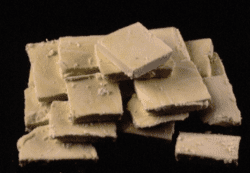Castile Olive Oil Soap, Spain, 2000 BCE
Legend has it that the first soap was accidentally produced on Mt. Sopa, a site of animal sacrifice. As the goat meat burned, fat dripped down through the fire, bonding to lye leaching out of the ashes. The combination flowed down the mountainside and collected in the clay of the riverbanks, where women used the clay to scrub laundry clean. Although soap was known in the Fertile Crescent as early as 2000 BCE, it was used in the treatment of wounds and in hairdressing before its cleansing properties were understood. In the Mediterranean, soap was entirely unknown: Egyptians and Romans used oils for bathing and the Egyptians used natron, a crystallized rock of brine, to launder clothes. Although some individual Viking and Celtic tribes discovered soap independently, it was not widely known in Europe until the Arab invasion of the Byzantine Empire. It took considerably longer for the invention to reach northern Europe; the Celts are credited with introducing soap to Britain in 1000 CE. Although the Arabs used animal fat for their soaps, the abundance of olive trees in the Mediterranean area led to the development of soaps based on olive oil and lye from the ashes of the barilla, a common plant. The soap shown here is Castile soap, an olive oil soap of the region of Castila, Spain.
Method of Construction
Constructed by: Jean Kahler and Alena Shumway
This soap is made from olive oil, lye and water. Lye is commonly packaged in powdered form for unclogging drains and is available at most hardware stores. It is extremely caustic and must be handled carefully with thick rubber gloves. The lye is added to water, and gets hot quickly due to the chemical reaction between the two. Then the oil is heated and added to the lye-and-water mixture and stirred. The mixture is poured into a large pan and allowed to cool and set for several days, and it must be stirred every twelve hours for the first day or two. Then it is cut into bars, but it will be too caustic to use for another three weeks.
Sources, Resources and Links
Soap: https://www.angelfire.com/pages/soap1214/index.html
Soapmaking: https://www.lysator.liu.se/ftp/pub/religion/neopagan/herbs/uses/soap/soapmaking




